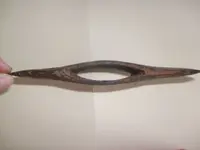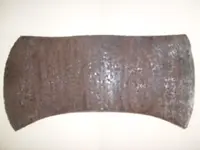cti4sw
Bronze Member
- Joined
- Jul 2, 2012
- Messages
- 1,555
- Reaction score
- 919
- Golden Thread
- 1
- Location
- Pennsylvania
- 🥇 Banner finds
- 1
- Detector(s) used
- Minelab Equinox 600, Garrett AT Pro, Pro Pointer
- Primary Interest:
- Relic Hunting
I found this axe head at a site that dates to the early 1700s, although the most recent house was built in the mid-1800s.
I believe this to be a Rockaway type due to the rockers at the base, but the loop at the top has me mystified. Can anyone tell me what the loop might have been used for? Also looking for a type confirmation and an age range.
The head itself is roughly 4" x 5".
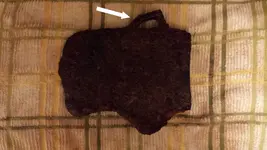
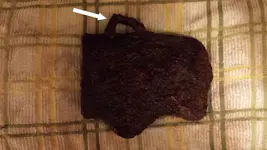
Thanks!
UPDATE 7/9/2014
So, I concur with anyone who disputed my idea that it's a Rockaway type. As more of the rust comes off with electrolysis, the lines are straighter and the curves disappear. Someone (outside of TNet) suggested a Philadelphia/Jersey style plus a strap loop for horseback carry. The curvature I thought I saw at the top has come away with the rust to reveal a straight line from the head to the blade, and the roundness of the rockers have become more pointed as the rust flakes away.
I will be brushing it up tomorrow, hopefully for the last time, stubborn rust I've found using a small hammer on a flathead screwdriver with a plastic handle as a chisel can remove larger chunks without damaging the original metal too much and it's allowed me to remove more of the rust than just the wire brush or ACV. Once it's brushed to my satisfaction I will post pictures.
I've found using a small hammer on a flathead screwdriver with a plastic handle as a chisel can remove larger chunks without damaging the original metal too much and it's allowed me to remove more of the rust than just the wire brush or ACV. Once it's brushed to my satisfaction I will post pictures.
UPDATE 7/10/2014
The pictures I promised:
Side profile
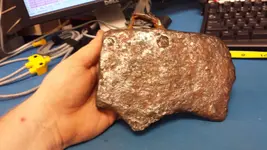
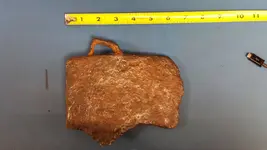
Top and blade
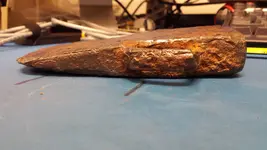
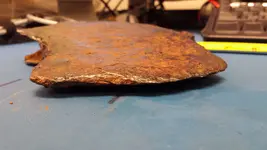
Hammer head end
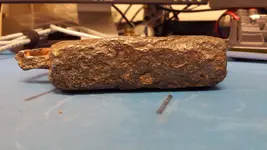
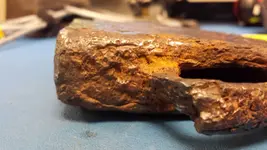
Strap loop
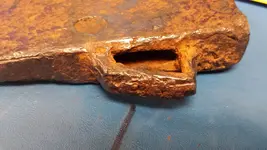
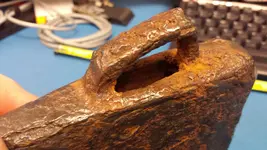
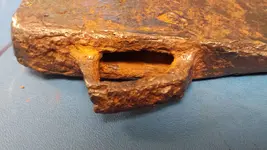
Handle shaft
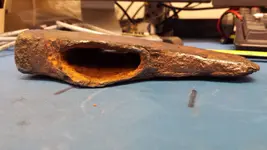
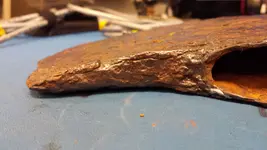
I believe this to be a Rockaway type due to the rockers at the base, but the loop at the top has me mystified. Can anyone tell me what the loop might have been used for? Also looking for a type confirmation and an age range.
The head itself is roughly 4" x 5".


Thanks!
UPDATE 7/9/2014
So, I concur with anyone who disputed my idea that it's a Rockaway type. As more of the rust comes off with electrolysis, the lines are straighter and the curves disappear. Someone (outside of TNet) suggested a Philadelphia/Jersey style plus a strap loop for horseback carry. The curvature I thought I saw at the top has come away with the rust to reveal a straight line from the head to the blade, and the roundness of the rockers have become more pointed as the rust flakes away.
I will be brushing it up tomorrow, hopefully for the last time, stubborn rust
 I've found using a small hammer on a flathead screwdriver with a plastic handle as a chisel can remove larger chunks without damaging the original metal too much and it's allowed me to remove more of the rust than just the wire brush or ACV. Once it's brushed to my satisfaction I will post pictures.
I've found using a small hammer on a flathead screwdriver with a plastic handle as a chisel can remove larger chunks without damaging the original metal too much and it's allowed me to remove more of the rust than just the wire brush or ACV. Once it's brushed to my satisfaction I will post pictures.UPDATE 7/10/2014
The pictures I promised:
Side profile


Top and blade


Hammer head end


Strap loop



Handle shaft


Amazon Forum Fav 👍
Last edited:





